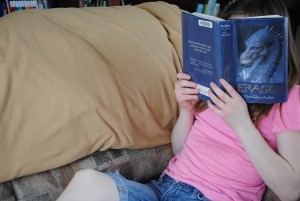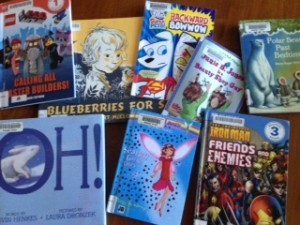Angela Ackerman's Blog: Writers Helping Writers, page 151
April 13, 2015
3 Ways to Use Pinterest to Promote Your Book
Happy to welcome Jill Bennett today to discuss Pinterest, a social media platform that is quite versatile when it comes to functionality for both writing and marketing. The added benefit is that not only can Pinterest help writers plan novels and reach a readership, by nature it is a cornucopia of creativity, full of inspiration for new writing projects as well. I would love to hear about the ways you use pinterest in the comments!
 Pinterest is an image-based social media platform. Small businesses that focus on fashion, food, crafts and decorating ideas have thrived on its online community. However, this doesn’t mean the rest of the business world can’t fit in this platform, because there are countless ways to use images to reflect a business’ products and services, and in your case, your book.
Pinterest is an image-based social media platform. Small businesses that focus on fashion, food, crafts and decorating ideas have thrived on its online community. However, this doesn’t mean the rest of the business world can’t fit in this platform, because there are countless ways to use images to reflect a business’ products and services, and in your case, your book.
1. Reach out to Book Fans
You may think that Pinterest is just for wedding planners, brides and decoration aficionados, but there are several groups of Pinterest users that you will surely be interested in: readers, writers and aspiring authors. Book fans and other authors abound in Pinterest. They have pins and boards dedicated to photos of their favorite books, book recommendations, grandiose libraries and bookshelves, quotes from authors, writing tips and so much more.
So, this brings me to my next point. Use Pinterest for link building.
2. Drive Traffic to Your Website
 Pinterest’s platform is delivered as a personal bulletin board. You are free to create boards to organize your images, and you pin images to these boards the same way you would pin a photo to a corkboard. So, to advertise your book, you could create a board for photos of your book, and then pin your cover image to that board. You could also create a board for quotes, and then creatively design quote pictures to pin on that board. The possibilities are endless.
Pinterest’s platform is delivered as a personal bulletin board. You are free to create boards to organize your images, and you pin images to these boards the same way you would pin a photo to a corkboard. So, to advertise your book, you could create a board for photos of your book, and then pin your cover image to that board. You could also create a board for quotes, and then creatively design quote pictures to pin on that board. The possibilities are endless.
An amazing thing about Pinterest is that you can link your photos so that when someone clicks on your pin, they are automatically redirected to your website. This means instant traffic to your site.
Be careful when uploading a photo from your computer because Pinterest won’t automatically prompt you to insert a link. Follow these instructions to make sure your website will enjoy all that Pinterest link juice.
Uploading a Pin
Step 1: Log in to your Pinterest account and click the plus sign at the bottom right corner of the screen.
Step 2: Choose “Upload a Pin” and select an image from your computer.
Step 3: Pick a board for that pin and include an accurate description.
Step 4: Click “Pin it”.
Step 5: View the image you just pinned either by clicking “See it now” on the page that appears after hitting the “Pin it” button or by navigating to the board where you pinned the image.
Step 6: Click the Edit button at the top of the image and insert your desired link into the “Source” field. Choose “Save Changes” and you’re done.
Pin from a Website
Step 1: Log in to your Pinterest account and click the plus sign at the bottom right corner of the screen.
Step 2: Choose “Pin from a website” and enter the link of the page where the image is located.
Step 3: Select the photo you want to pin from the list of images Pinterest extracts from that page.
Step 4: Pick a board for that pin and include an accurate description.
Step 5: Click “Pin it”.
Note: This method will make Pinterest automatically insert a link to the image’s source page, so there’s no need to manually insert the link like when uploading a pin. Make sure to enter the link to the page, not the image’s permalink. Otherwise, Pinterest will just open the image file in a new browser tab.
The “Pin It” Button
Pinterest has a browser extension for Google Chrome, Internet Explorer, Firefox and Safari. When you have this button installed, you can pin images from almost any website with one click. The extension eliminates the need to upload an image or insert a link.
Install the “Pin It” button compatible to your browser to make pinning easier. Simply move your mouse to an image on any webpage and click the “Pin It” button that appears on the picture.
Important: Regarding citing sources, Pinterest will automatically place the pin’s original location when you use the “Pin It” button.
3. Get Repins and Likes to Boost Author Brand
You can pin images that personally interests you, but this doesn’t guarantee that you’ll get noticed. You know that your Pinterest campaign is successful when other users like and repin your images. Many blogs and articles will tell you dozens of ways to get repins, but the most important tactic is to pin what your followers and target audience will love and find valuable.
Here are pin ideas for authors:
A list of your books
Cover photos of your books
Promotions and events you’re doing
Images that visually represent or display your book’s themes, tone and mood
Photos of your writing inspirations
Writing tips
Stunning book covers by other authors
Pictures of books and bookshelves
Motivational quotes
You can also add a personal touch to your Pinterest by adding boards for your personal interests, such as recipe, DIY and fashion boards.
Here are more tips to supercharge your Pinterest marketing.
Choose the right words for the description.
Using keywords in the description will help make your pins visible on Pinterest’s search results pages. If you have a young adult fiction book, for example, make sure to place “young adult” in the description.
Turn article headlines into images.
 Since Pinterest is heavily image-based, it’s hard to make texts in the description section to stand out, which is why the best alternative is to put the text in the image itself. Take a look at these pins by media company BuzzFeed.
Since Pinterest is heavily image-based, it’s hard to make texts in the description section to stand out, which is why the best alternative is to put the text in the image itself. Take a look at these pins by media company BuzzFeed.
To get your website content noticed, create effective headlines and turn them into images. How-to articles are particularly popular on the social media site. Don’t forget to include a link to the webpage.
Use hashtags.
Hashtags will increase your pins’ exposure, but don’t go overboard with them. Two to three should be enough.
Make use of trending topics.
You could tie your author brand’s message with a trending topic and post images based on that.
Share your pins on Facebook and Twitter.
Be careful when doing this because Facebook and Twitter users tend to be fussy over people who overshare on social media.
Repin other people’s content.
On most social media sites, people tend to reciprocate the love they receive from other users. Like and repin other people’s content, and they will return the favor. Of course, if you follow hundreds of accounts, it’s going to be hard to catch their pins on your feed.
Join a community board.
This is great especially if you’re new to the site and don’t have many followers yet. By joining a group board, your pins will be visible to followers of that board. That means you expose your content to people outside of your own Pinterest circle. You have to be invited by a group member to be part of a community board.
To be invited, follow a group board, repin their pins and follow the group’s creator. Befriend the creator of the group by liking and leaving comments on their posts. They will most likely notice you and see you as a possible good contributor for the shared board.
Increase your follower base.
Start by following other people. Most of them will follow you back. Follow people who may be interested in your pins so that you will actually get likes and repins. Check out their boards to see their interests.
Pinterest could become one of your most powerful marketing tools. Use it to grow your audience and drive website traffic.
Jill Bennett is a Book Marketing Specialist at LitFire Publishing, a self-publishing company based in Atlanta, Georgia.For the past six years, she’s been working with several self-publishing authors in terms of book marketing, publicity and distribution.
References:
http://www.mcngmarketing.com/how-to-join-a-group-board-on-pinterest/#.VPUiqfmUfrn
http://www.whiteglovesocialmedia.com/social-media-marketing-how-to-get-more-repins-and-attract-more-pinterest-followers/
http://www.thebookdesigner.com/2013/10/how-to-use-pinterest-to-promote-your-book/
HOW DO YOU USE PINTEREST TO MARKET? Let us know in the comments!
The post 3 Ways to Use Pinterest to Promote Your Book appeared first on WRITERS HELPING WRITERS™.
April 11, 2015
Talents and Skills Thesaurus Entry: Multitasking
As writers, we want to make our characters as unique and interesting as possible. One way to do this is to give your character a special skill or talent that sets him apart from other people. This might be something small, like having a green thumb or being good with animals, to a larger and more competitive talent like stock car racing or being an award-winning film producer.
When choosing a talent or skill, think about the personality of your character, his range of experiences and who his role models might have been. Some talents might be genetically imparted while others are created through exposure (such as a character talented at fixing watches from growing up in his father’s watch shop) or grow out of interest (archery, wakeboarding, or magic). Don’t be afraid to be creative and make sure the skill or talent is something that works with the scope of the story.

Photo copyright: Ryan Ritchie @ Creative Commons
Description: Being able to do several things simultaneously
Beneficial Strengths or Abilities: Being able to split one’s focus between multiple jobs or projects; being able to follow multiple conversations that are going on at once time
Character Traits Suited for this Skill or Talent: alert, adaptable, industrious, efficient, controlling, easygoing
Required Resources and Training: Multitasking is often one of those skills that people either have or they don’t have. But people can become better with practice by deliberately splitting their focus while more than one thing is going on
Associated Perceptions:
Organized people are the best multitaskers. Sometimes, it’s the people with less organized minds who are able to fragment their thinking and get many things done at once.
Multitaskers can do anything while doing ten other things at once. Studies show that certain kinds of tasks (like those where learning is involved) are very difficult to do while multitasking.
Multitasking is always the best option. Some tasks can be done while multitasking but would be done better if the person was completed focused on the task at hand (driving, for instance).
Multitasking is touted in today’s society as a highly desirable ability, but constant multitasking can lead to burnout, sloppy work, exhaustion, and the inability to delegate to others. It can also be a detriment to personal relationships when someone can’t give a loved one his/her complete attention. It would be easy to use this ability in a way that goes against common thinking by showing it in a negative light, or dropping a chronic multitasker into a community where it’s seen as a weakness rather than a strength.
Scenarios Where this Skill Might be Useful:
When leading a large group of people
When big jobs (or numerous jobs) have to be done in a short period of time
When one person is responsible for many different projects
When there is no one else suitable or available to take on a new job
For tasks that don’t need a high level of expertise or attention (such as folding laundry, unpacking kitchen boxes, or filing folders)
Resources for Further Information:
Training Your Brain to Multitask
How to Multitask without Losing Your Mind
You can brainstorm other possible Skills and Talents your characters might have by checking out our FULL LIST of this Thesaurus Collection. And for more descriptive help for Setting, Symbolism, Character Traits, Physical Attributes, Emotions, Weather and more, check out our Thesaurus Collections page.
The post Talents and Skills Thesaurus Entry: Multitasking appeared first on WRITERS HELPING WRITERS™.
April 7, 2015
Getting into the Head of a Character Who Is Completely Different from You
I have this joke about my husband’s family. They all have larger-than-life, really obvious character traits. OCD tendencies, extreme fairness, being super loud—really interesting characteristics that I don’t happen to share. Not only do I love these people for their unique qualities, I love them because they’ve made it possible for me to write characters who share their qualities—characters who would’ve otherwise been really difficult to write, since I was so far removed from them.
We’ve all been in that situation of trying to write a character who was nothing like us, and it’s not easy to do. But Alexander Limberg is here today to share 3 helpful tips on how to get into the head of your characters and write them well and realistically.

Why can’t you just be more like me? *
Say there’s this guy you just can’t get along with. You’ve tried everything to make it work. You attempted to be tolerant about his annoying sense of entitlement; you did your best to see the positive in his constantly reserved manner; you tried not to judge his ridiculous correctness. But you don’t understand him. He’s just completely different than you.
It wouldn’t be so bad, except you’re both involved with an important project and see each other almost on a daily basis. The good news? He only exists on paper – as a character in your next novel. But if you want to make that novel work, you better get to understand him as well as you understand your very best friend.
It’s not the easiest thing to do, but I’ve got some ideas for how you can slip into the shoes of any character, even if the two of you are wildly different.
Use People You Know Who Are Similar To Your Character
Let’s face it: we’re experts at summing other people up—usually by their most obvious character traits. So-and-so is stingy, or touchy-feely, or hard working. That other person is humble, or dishonest, or a busybody. Chances are, we’ve known or encountered a person in real life who shares a trait or two with our characters. Siblings, parents, neighbors, co-workers, and the checkout lady at the grocery can all be used to help you write dozens of different characters.
Most of your characters won’t exactly mirror their real life prototypes because you’re writing fiction, not a biography. Instead, your figures will be hybrids of the people you know: for example, as brilliant as your sister and as restless as your best friend.
Take from everybody what you need. The more life experience you have and the more characters you have met over the course of your life, the better! Society is just a big, yummy, never-ending buffet of character traits. Feast at your convenience, and bring your unique cast of characters to life.
Don’t Act. Be!
In some ways, writing is like acting. The difference is that you have to be everyone at once. Switching between characters from one moment to the next is an ability that distinguishes great writers from the not-so-great ones. It’s a lot like method acting.
In method acting, you don’t try to pretend you’re a different character. Instead, you ask yourself: “If I was that cheerful/vain/sneaky/dumb, how would I act?” As you answer that question, you move into a different headspace. You’re doing what the best authors in the world are really good at: They don’t act, they are. For a brief moment, they are that character, with all of their being.
It’s a small step between pretending and being. So the next time you’re trying to write a character who’s not at all like you, just ask yourself: “How would I act if…?”
Recall a Situation that Brought out the Opposite in You
We all have multiple sides to our personalities. Sad individuals are occasionally joyful, mature people can be childish, and yes, even the dumb ones are smart sometimes. Likewise, that trait that your character embodies may not be an obvious attribute of yours, but you’re likely capable of acting that way. It’s actually very possible that you have been that way for a period of time in the past.
Perhaps your character is extremely confident, and you’re not. Surely there was a time in your life when you did feel confident—maybe, right after you got your promotion or passed that exam in university, you felt on fire and were invincible for the next couple of days.
Close your eyes and remember that time: What was different? What did you see, or smell, or hear? How did you feel? Try to revisit that time with your entire body. Yes, it might sound overly esoteric, but give it a try. The experiences, and your character’s traits, are most likely hidden deep within you. Just tap into your emotional memory and put that character down on paper.
Writing about a seemingly foreign character isn’t easy, but then what part of the writing process is? Hopefully these tips on how to temporarily be someone else will come in handy. Now it’s your turn: Have you ever written a character who was very different from you? How do you write someone whose nature is nothing like yours? Let us know in the comments!
* Photo Copyright: © Esolex/Dreamstime.com
 Alex Limberg is the founder of Ride the Pen, a creative writing blog that dissects famous writers (works, not bodies); his blog offers detailed writing prompts. Make your story great by checking your character development with 10 crucial questions from his free e-book. The ebook contains ‘44 Key Questions’ in total to test your story. Alex has worked as a copywriter in a Hamburg advertising agency and with camera and lighting in the movie business. He lives in Austria and has previously lived in Los Angeles and Madrid.
Alex Limberg is the founder of Ride the Pen, a creative writing blog that dissects famous writers (works, not bodies); his blog offers detailed writing prompts. Make your story great by checking your character development with 10 crucial questions from his free e-book. The ebook contains ‘44 Key Questions’ in total to test your story. Alex has worked as a copywriter in a Hamburg advertising agency and with camera and lighting in the movie business. He lives in Austria and has previously lived in Los Angeles and Madrid.
The post Getting into the Head of a Character Who Is Completely Different from You appeared first on WRITERS HELPING WRITERS™.
April 4, 2015
Character Talent and Skills: PSYCHOKINESIS
As writers, we want to make our characters as unique and interesting as possible. One way to do this is to give your character a special skill or talent that sets him apart from other people. This might be something small, like having a green thumb or being good with animals, to a larger and more competitive talent like stock car racing or being an award-winning film producer.
 When choosing a talent or skill, think about the personality of your character, his range of experiences and who his role models might have been. Some talents might be genetically imparted while others are created through exposure (such as a character talented at fixing watches from growing up in his father’s watch shop) or grow out of interest (archery, wakeboarding, or magic). Don’t be afraid to be creative and make sure the skill or talent is something that works with the scope of the story.
When choosing a talent or skill, think about the personality of your character, his range of experiences and who his role models might have been. Some talents might be genetically imparted while others are created through exposure (such as a character talented at fixing watches from growing up in his father’s watch shop) or grow out of interest (archery, wakeboarding, or magic). Don’t be afraid to be creative and make sure the skill or talent is something that works with the scope of the story.
PSYCHOKINESIS
Description: the ability to move objects using only the power of one’s mind
Beneficial Strengths or Abilities: having control of one’s emotions, being able to enter and keep a meditative state even when there are distractions, being highly knowledgeable in chakras (nodes of life force energy in the body) and how to manipulate that energy, having intense concentration and control over one’s breathing and heart rate
Character Traits Suited for this Skill or Talent: focused, open-minded, determined, centered, spiritual, ambitious, tranquil, talented, calm
Required Resources and Training: training exercises with a paper psi wheel (using it as a focus center to visualize being one with it and then using one’s psychic energy to move the psi wheel), being mentored by a teacher who has mastered the chakra healing, intense practice sessions to learn how to collect and control one’s own energy
Associated Stereotypes and Perceptions:
in real life, many believe that people who claim to have psychokinetic abilities are simply sleight-of-hand masters
Scenarios Where this Skill Might be Useful:
In situations where one must collect or gather something beyond reach (jail cell keys, pickpocketing for one’s survival, stealing food to eat, pulling a weapon toward oneself for defense, etc.)
When something requires maintenance or fixing but it is too dangerous to be close to (a machine within range of a radiation leak, drawing blood from a patient who is under quarantine, working with toxic chemicals or bio hazards in the lab
Working with animals that are dangerous, untamed or simply just afraid (being able to slip a noose over a rabid dog’s head without being bitten as a dog catcher, etc.)
Playing tricks on people or using one’s skills for entertainment and fame
During disaster relief (earthquakes, tornadoes, etc.) when people and animals must be dug out of the rubble quickly
When one must transfer something from one person to the next without anyone seeing (a thumb drive with sensitive information on it, a safe code or set of instructions on a piece of paper, a medicine pill or syringe, etc.)
You can brainstorm other possible Skills and Talents your characters might have by checking out our FULL LIST of this Thesaurus Collection. And for more descriptive help for Setting, Symbolism, Character Traits, Physical Attributes, Emotions, Weather and more, check out our Thesaurus Collections page.
Image: Pixabay 494640
The post Character Talent and Skills: PSYCHOKINESIS appeared first on WRITERS HELPING WRITERS™.
April 2, 2015
The Importance of Grounding Characters in the Reader’s World
We all know how important it is to build fully-fleshed characters by digging at their core. Exposing their attributes, flaws, morals, emotional wounds and fears that revolve around their basic human needs will influence their goals and desires within the story. And to make a protagonist really sing, most authors push to include unique qualities to set them apart. After all, a memorable character sticks with us past the last page, and keep us watching the author’s website to see when the next book releases. This type of deep connection makes an author worthy of remembering, “selling” the author’s skills to readers and turning them into fans.
 In addition to creative character-building to win the audience over, authors try to also dream up settings and situations that will also provide a rich, vivid experience. Readers want to be immersed in something new and special, and with the plethora of genre mash ups we see this days, the sky is the limit.
In addition to creative character-building to win the audience over, authors try to also dream up settings and situations that will also provide a rich, vivid experience. Readers want to be immersed in something new and special, and with the plethora of genre mash ups we see this days, the sky is the limit.
However, in all this planning to offer a story world and set of characters that feel excitingly different, sometimes authors forget to deliver on a very critical piece of the reader-character relationship: relatability.
The Mirror of Fiction
Why is relatability so important? Well, because even though your readers are looking to experience something new, they also are searching for context. What do I mean by that? Simply that as they glance through the window into your story world, they are also trying to see deeper into their own. Entertainment value aside, people also read to understand the human experience and find meaning in their own life’s story, and better see how they fit into the world around them.
Sounds heavy, doesn’t it? But I bet if you think about the books you really connected with on an emotional level, in some way you felt a strong kinship with the protagonist, either because of who they were deep down or what they wrestled with in the story.
Emotional Anchors Bring Readers and Characters Together
 A character becomes relatable when we actively join the human experience with fiction. It doesn’t matter what genre you write, or how alien the character’s world and experiences are from the reader’s own. Some constants are just that–constants. Emotional anchors (emotion-rich events that readers have experienced themselves) will ground your hero in the reader’s world. Here’s a few anchors to drop into your character’s experience that readers will recognize and relate to:
A character becomes relatable when we actively join the human experience with fiction. It doesn’t matter what genre you write, or how alien the character’s world and experiences are from the reader’s own. Some constants are just that–constants. Emotional anchors (emotion-rich events that readers have experienced themselves) will ground your hero in the reader’s world. Here’s a few anchors to drop into your character’s experience that readers will recognize and relate to:
Give the character a difficult choice between two equally painful options. We’ve all been in this situation, and understand the turmoil such a moment causes.
Show the character make a mistake and have to face the fallout. Again, no one is perfect, and our lives are peppered with moments where we had to deal with the aftermath of screwing up.
Have the character question right and wrong. While we all like to believe we have a strong moral compass, sometimes moral greys get us. In difficult circumstances, the path isn’t always clear, and the doubt a character feels regarding what is right will act as an echo to the reader’s own distress they felt when faced with moral ambiguity.
Allow the character to strive for something he wants more than anything and then fail to attain it (or win it only and lose it again.) Feelings of loss and failure are universal when an upset happens, so this experience will tweak a reader’s emotional memory, reminding them of when they too suffered a loss that hurt.
Pull the curtain aside and reveal raw insecurity through a common worry or fear. A character can be wealthy, talented, blue-blooded or a host of other things possibly outside an average reader’s experience, yet still have some of the same insecurities most people do. Everyone wants to be cared for, valued, accepted, or respected for something. Show your character worry about little things that hint at hidden insecurities, perhaps ones that people like to mask in real life (triple checking for mistakes before handing work over, experiencing indecision over what is best to wear, the fearful belief one will do or say something stupid at the wrong moment, etc.)
Relatability is what helps an empathy bond form between the reader and your characters. It isn’t enough for a reader to simply like or admire a character. Our goal, our true goal as authors, is to make the reader feel. So when they can relate to a character in a meaningful way, they also empathize, and hopefully that feeling of having a “shared emotional experience” will manifest.
How do you make your character relatable to readers? Let us know in the comments!
Image 1: pixabay JohnHain
Image 2: Pixabay PDPics
The post The Importance of Grounding Characters in the Reader’s World appeared first on WRITERS HELPING WRITERS™.
March 31, 2015
Kids and the Decline of Reading, Part 2: What We Can Do As Authors

Pixabay
In case you missed it, I posted last week about the decline of reading among kids (particularly teens), and how we could head that off at home. Some good ideas were generated, and I came away from the discussion with a particularly encouraging bit of news: many of you said that while your kids did stray from reading during the teen years, those who loved reading as a child often came back to it as an adult. That was good to hear.
So, as was mentioned in that post, if we want our kids to love reading, there are some things we can do at home to encourage that. But as authors—as the ones writing the books that we want our kids to eventually read—we also have a vested interest in this issue. Here are some steps we can take in that direction:
1. Write the books that excite us. When we write with passion, it comes through in the finished product. Being excited about our work drives us to keep at it, do it better, and make the end result awesome. If we want to provide kids with books that are exciting and full of life, we need to write the stories that excite us. As with any art form, passion translates well into the written word; it will come through in our stories.
2. Write the books that kids want to read. I know, I just said to write the book that you want to write. And it’s all well and good to be jazzed about a given topic; if you’re excited to write about Jar Jar Binks’ favorite snack foods, then by all means, go for it. Written well enough, there’s a market for just about anything. But if we want to engage kids, our best chance is to combine our passion with the kinds of books that kids want to read. Talk to librarians. Talk to classroom teachers. Better yet, talk to the kids themselves. What topics hold their interest? Which books are their favorites, and why? What kinds of books would they like to see on their library shelves? If you can learn what kids are looking for, you just might hear something that gets you all worked up, enabling you to write a book that kids want to read AND one that you’re excited about. The best of both worlds.
Sidebar: One thing that most kids like? Humor. According to a recent Scholastic Reading Report, 70% of kids want books that make them laugh. Also high on the list: books that tell a made-up story, allow them to use their imaginations, contain the kind of characters that kids emulate, teach them something new, or provide a mystery or problem to solve.

Pixabay
3. When possible, provide ways for teachers to use your books in the classroom. One of the big issues discussed in the comments of last week’s post was the required reading in classrooms and how the books themselves were turning kids off of reading. If we don’t like the kinds of books that are being used in classrooms, we need to be writing the books that teachers can use, and making it convenient for educators to use them.
Donna Gephart writes funny, contemporary middle-grade books that aren’t the typical required reading in classrooms, but she provides reading and activity guides for all of her books so teachers have ready-made lesson plan options for kids who read them. And teachers are using them. Another example is author Christina Farley, who recently spoke at a school in Seoul where Gilded, her young adult contemporary fantasy, had been read by the entire 8th grade class. Christina also provides Unit Study Guides and Common Core Educator’s Guides for her books, making it easy and appealing for teachers to use her books in the classroom.
Most teachers are actively seeking materials that will engage their students while helping them meet core criteria. After you’ve written a great book, be sure to provide materials for teachers, making it convenient and easy to incorporate those books into their lesson plans.
4. Provide books in kid-friendly formats. We know that the average teen is addicted to his/her phone and uses it for much more than its original purpose; kids use them to watch movies and TV shows, play games, view YouTube videos—all pleasure activities that are easy to do on the phone because the phone is always with them. While most kids still prefer print books, it’s my belief that digital books are going to increase in popularity simply because reading them is one more thing that can be done on a phone or tablet. Again, it’s about convenience for the consumer. Whenever possible, we should be reaching kids on their level and making books available in whatever format they’re most inclined to use.
5. If you’re a published author, engage in school visits. While it’s likely that teachers and many of their parents are trying to get kids to read, author visits introduce students to yet another human being who sees reading as valuable. It’s one more person saying, “Hey, this is important!” It reinforces what is hopefully already being taught. And it gives kids insight into not only the writing process but a viable career option that they may not have considered—one in which they might become authors who help to encourage the next generation of kids to read.
So those are my grand ideas for solving the problem of kids who aren’t so interested in reading. Problem solved ;). Seriously, you all offered some great advice last week on how to address this problem at home. What else can we do as authors?
The post Kids and the Decline of Reading, Part 2: What We Can Do As Authors appeared first on WRITERS HELPING WRITERS™.
March 28, 2015
Talents and Skills Thesaurus Entry: Enhanced Sense of Smell
As writers, we want to make our characters as unique and interesting as possible. One way to do this is to give your character a special skill or talent that sets him apart from other people. This might be something small, like having a green thumb or being good with animals, to a larger and more competitive talent like stock car racing or being an award-winning film producer.
When choosing a talent or skill, think about the personality of your character, his range of experiences and who his role models might have been. Some talents might be genetically imparted while others are created through exposure (such as a character talented at fixing watches from growing up in his father’s watch shop) or grow out of interest (archery, wakeboarding, or magic). Don’t be afraid to be creative and make sure the skill or talent is something that works with the scope of the story.

Pixabay
Description: Being able to detect even trace amounts of odors and identify them.
Beneficial Strengths or Abilities: Good sinus health, a strong memory, past exposure to many different scents
Character Traits Suited for this Skill or Talent: curiosity, focus, observant, aware, tolerant, adventurous, nosy, perfectionistic
Required Resources and Training: There are two parts to having a strong sense of smell: being able to detect scents, and being able to identify them. When it comes to being able to smell different odors, people are usually born strong or weak in this area. Someone wishing to strengthen their sniffer could do so through focused practice, but only to a certain degree. If a person is able to detect many smells, identifying them becomes a matter of exposing oneself to a variety of odors and remembering them so they can be recalled when a scent arises.
Associated Stereotypes: People who can smell things really well are often the ones with the largest noses. And they’re audibly sniffing; everywhere they go, other people can hear them constantly scenting the air.
Scenarios Where this Skill Might be Useful:
When a toxic element is in the environment
When someone is about to be poisoned
When an item or person has gone missing and must be tracked
At a crime scene
When a catastrophe or apocalypse is coming and the event is preceded by changes that can be detected with the sense of smell
When someone needs to solve a mystery
When a chef needs to identify the ingredients in a dish
When identifying edible plants in the wild
When it’s necessary to identify people by their perfume, shampoo, or other smells
Resources for Further Information:
How to Sharpen Your Sense of Smell
Improve Your Sense of Smell Without Using Your Nose
Quiz: Facts About the Sense of Smell
Related Talents and Skills: Enhanced Taste Buds
You can brainstorm other possible Skills and Talents your characters might have by checking out our FULL LIST of this Thesaurus Collection. And for more descriptive help for Setting, Symbolism, Character Traits, Physical Attributes, Emotions, Weather and more, check out our Thesaurus Collections page.
The post Talents and Skills Thesaurus Entry: Enhanced Sense of Smell appeared first on WRITERS HELPING WRITERS™.
March 24, 2015
Kids and the Decline of Reading, Part 1: What We Can Do At Home

Courtesy: Pixabay
As a mother of a 5- and 6-year-old, I’m always curious about reading trends in the kid world, and how to get children to like reading. I know that reading is on the decline with kids, but I was still slightly appalled to hear about this conversation between my husband and one of the teenaged employees at his quick-service restaurant:
Employee: Has anyone seen The Maze Runner? Is it any good?
Husband: It was pretty good. But you should read the book. It was awesome.
Employee: Why would I read the book when I can just go see the movie?
Husband: Because the book is almost always better than the movie.
Employee: *rolls eyes* Only old people say that.
This struck me to the heart—like a failing pacemaker, I presume, since I’m apparently OLD. Maybe it was the way she said it: very nonchalant, like her viewpoint on the subject was beyond commonplace and she couldn’t believe that adults couldn’t get up to speed on the fact that reading is a last resort for teens.
Maybe it shocked me because just a week before, we had finished an extended family lunch, and when the kids disappeared to do their own things, my thirteen-year-old neice retired to the couch for a bit of texting. Totally nothing wrong with that. Completely natural for a teenager to dash for the phone upon being released from a dinner with the old farts. But I couldn’t help thinking that if that had been me however many years ago, I would have been curled up with a book. And it made me sad. I want my kids to have the same happy experiences with books that I did, and with the advance of technology, that’s becoming less and less likely.
And then, to add insult to mortal injury, I found this dreadful little pictograph at Jane Friedman’s blog (it’s at the top of the post, so you can click over to view it); it shows how books rate in comparison to other interests for kids. As you can see, reading is at the top of most kids’ radar through age 10, after which point it makes a sharp dive until the age of 14, when books don’t even make the top 8.
Maybe I’m the only one, but this FLOORED ME. I think that, despite many conversations on this topic, authors don’t always recognize how widespread and real the disparity is becoming between kids and books. As writers, most of us love to read, and we hang out with people who love to read, and we’re all on a mission to instill a love of reading in our kids, so many of our kids and our friends’ kids like to read. So when we hear about the declining interest in books among teens, we’re all, Oh, that’s awful. But we don’t realize how true it is because we see information to the contrary within our own little authorial bubbles, where books are a huge priority. We don’t really get what it’s like for the rest of the world.
Well, now I get it.
And the question becomes: how do we reverse the decline?
For me, I think the answer is two-pronged, consisting of what we can do at home and what we can do in the industry. This post is already dragging on long enough to turn off avid readers, so today I’m going to address the first point and come back to the second part another time. I’d like to start by sharing some of my personal ideas for raising the value of books and reading at home (or at school). This is a very short, very individualized list of things that have worked for me, so I’m really hoping that you all will add to my ideas in the comments section.
1. Make Reading a Desirable Activity. These days, kids have a lot of choices about how to spend their free time. If they view reading as something boring, it’s always going to be low on their priority list. So come up with ways to make reading a desirable option. My daughter is six, and while she reads well, it’s not her favorite thing to do; she’s incredibly people-oriented and will always choose a social activity over a solitary one, so I’ve had to come up with some underhanded unique ways to get her to read. One thing that has worked really well? I pushed back her bedtime and declared those 15 minutes to be “Reading Time”. She can read during that time, or, if she chooses not to, then she can go to sleep. You can guess what she picks. Now, every night, she reads for at least 15 minutes—sometimes more, if she’s really into her book and it’s not too late. Other ideas I’ve seen is to put books in places where kids spend a lot of time, like the bathroom and the car. Make reading the best possible choice, and they might do it more often.
2. Limit Other Activities. Now, I’m not saying that you throw the phone in the trash, because we don’t want to inadvertently spawn THE APOCALYPSE. But if our kids have access to electronics 24/7, they’re going to use them. And the likelihood of them doing anything else is small. It’s perfectly healthy to implement some electronics-free times or zones where electronics aren’t allowed (unless, of course, they’re being used to read a book). I think we would all be surprised what stimulating, creative, and quality activities kids take part in when phones and tablets aren’t an option. Reading might even be one of them.
3. Read Aloud to Them. I won’t belabor this point, since it’s long been lauded as the #1 way to encourage kids to read. But it’s true. If you want your kids to like books and they’re not old enough or interested enough to read them on their own, read to them. It’s still a great idea when your kids are older, because it enables you to learn which kinds of books they might be most interested in reading.
4. Discuss Books. This point kind of goes along with the last one in that when you discuss a book you’ve read with your child, or a book she’s read on her own, it elevates its value. A book is no longer something that you read to simply say that you read it; it has meaning and messages. It means different things to different people. In today’s technological world, kids are anatomically attached to their phones; connectedness—having access to other people 100% of the time—is a priority for them. Talking about books and stories can be a great way of connecting with your kids and turning a solitary activity into a social one.

My latest haul from the library.
5. Provide Kids With a Variety of Books. I love to read, but I don’t like to read everything. If you told me how awesome reading was and only gave me contemporary fiction, I would probably choose to sleep rather than read. This is one of the main problems I see with the reading programs in school. Kids are often taught to read using boring basal readers and group story books. In middle and high school, they’re forced to read books that they see as outdated and irrelevant, or books that are incredibly hard to understand. And we wonder why they don’t want to read.
Now, allow me to disclaim. I taught school for ten years, so I value what teachers do and I understand the importance of the classics. They teach students many valuable things, but, in most cases, they don’t teach them to love reading. One of the best ways to do that is to provide kids with the kinds of books that they like. If they don’t know which books those are, help them by exposing them to a variety of genres and styles. Get eclectic at the library or bookstore. Bring home books that cover your kid’s favorite hobbies or interests. Try different formats: novels, graphic novels, comic books, nonfiction, and biographies. My son is five and can only read the most basic of books on his own, but we’re reading our way through a Superman sticker book together, and I’m always ready to stop before he is. Explore the different kinds of books out there until you find something your kids love. Then drain that well dry.
6, Model Reading. This is another idea that has been praised to the point of Well, duh. As a teacher, as a mother, I’ve always known that if I want my kids to like reading, they need to see ME reading, see that I enjoy books and value them. I never imagined this being a problem, since reading has always been my #1 leisure activity. But, ironically, things changed when I had kids. Suddenly, I had no time for ANY leisure activities. Reading is the one thing I’ve held onto, but I’m only able to do it before bedtime. As a result, my kids don’t ever see me reading. When I realized this, I made it a priority to sit down at least once a day and read. In car line with my son, at home on the couch, at the park while my kids are playing—even if it’s just for ten minutes, if they can see that I’d rather read than check Facebook or crush candies or watch TV, then it becomes an activity that has value. And they’ll be more likely to explore it for themselves.
These are just a few of the things I’m doing to try and show my kids that reading is fun and books are important. But, honestly, they’re 5 and 6. I’ve heard a lot of stories from parents about how their kids loved books at this age but wouldn’t be caught dead reading for pleasure as a teen. This is an important issue for me, so I’d really love to hear your ideas on how you encourage reading, particularly as they apply to older kids.
The post Kids and the Decline of Reading, Part 1: What We Can Do At Home appeared first on WRITERS HELPING WRITERS™.
March 21, 2015
Character Talents and Skills: Talking with the Dead
As writers, we want to make our characters as unique and interesting as possible. One way to do this is to give your character a special skill or talent that sets him apart from other people. This might be something small, like having a green thumb or being good with animals, to a larger and more competitive talent like stock car racing or being an award-winning film producer.
 When choosing a talent or skill, think about the personality of your character, his range of experiences and who his role models might have been. Some talents might be genetically imparted while others are created through exposure (such as a character talented at fixing watches from growing up in his father’s watch shop) or grow out of interest (archery, wakeboarding, or magic). Don’t be afraid to be creative and make sure the skill or talent is something that works with the scope of the story.
When choosing a talent or skill, think about the personality of your character, his range of experiences and who his role models might have been. Some talents might be genetically imparted while others are created through exposure (such as a character talented at fixing watches from growing up in his father’s watch shop) or grow out of interest (archery, wakeboarding, or magic). Don’t be afraid to be creative and make sure the skill or talent is something that works with the scope of the story.
TALKING WITH THE DEAD
Description: the ability to communicate with those who have passed on, and if asked, convey messages between the living and dead
Beneficial Strengths or Abilities: being a qualified medium (having the ability to tune into the specific spirit energy of a person to see the past, present and future) or having strong psychic and/or intuitive abilities, living a clean lifestyle to become more receptive to spiritual energy, having control over one’s fears, having strong meditation skills, being able to protect or replenish one’s own energy to avoid being drained by others, being educated in psychology to better council any who are tormented after the passing of a loved one and who are seeking reassurances or closure through this type of communication
Character Traits Suited for this Skill or Talent: compassion, empathy, intuitive, focused, relaxed, intelligent, intrepid, protective, helpful, honest
Required Resources and Training: while a certain amount of this ability would come from a natural talent, learning how to focus that talent would likely require a mentor (another medium) who could guide the character in learning meditation and focusing skills. A quiet environment (a place of peace) would help one learn this focus and how to let go of any emotions that might cloud one’s ability and disrupt the connection between the living and dead. A psychic may choose to use a specific communication method that would also need to be learned and practiced (ball gazing, card reading, palmistry, reading a haunted object, etc.)
Associated Stereotypes and Perceptions:
Some believe that mediums and psychics are real, others do not. Of those that do, it is widely accepted that while true mediums exist, so do frauds
Scenarios Where this Skill Might be Useful:
speaking with past generations to collect their knowledge
having the deceased’s help regarding an event that caused great disruption (a king who died under mysterious circumstances, finding the location of an important document or will, or getting details from a girl who was kidnapped and murdered to find her body or track down her killer, etc.)
personal guidance in spiritual matters and gaining insight on what will come after death
helping to rid a person or place of malevolent spirits
offering loved ones closure by being able to convey messages between the living and dead
You can brainstorm other possible Skills and Talents your characters might have by checking out our FULL LIST of this Thesaurus Collection. And for more descriptive help for Setting, Symbolism, Character Traits, Physical Attributes, Emotions, Weather and more, check out our Thesaurus Collections page.
Image: PeterDargatz @Pixabay
The post Character Talents and Skills: Talking with the Dead appeared first on WRITERS HELPING WRITERS™.
March 18, 2015
Critiques 4 U! March Edition

Pixabay
I hope that Spring is springing wherever you are. This winter has been a hard one for many, so I’ll refrain from complaining about how the air has been on in my house for two weeks now and our eight-month Summer has already begun. No one wants to hear that. Least of all me.
What you DO want to hear is that IT’S CRITIQUE TIME again! If you’re working on a first page and would like some objective feedback, leave a comment that includes:
1) your email address
2) the working title of your WIP
3) its genre (no erotica, please)
4) the intended audience
ONLY ENTRIES THAT FOLLOW THESE INSTRUCTIONS WILL BE CONSIDERED.
3 commenters’ names will be drawn and posted tomorrow. If you win, you can email me your first page and I’ll offer my feedback. Best of luck!
The post Critiques 4 U! March Edition appeared first on WRITERS HELPING WRITERS™.
Writers Helping Writers
- Angela Ackerman's profile
- 1022 followers



